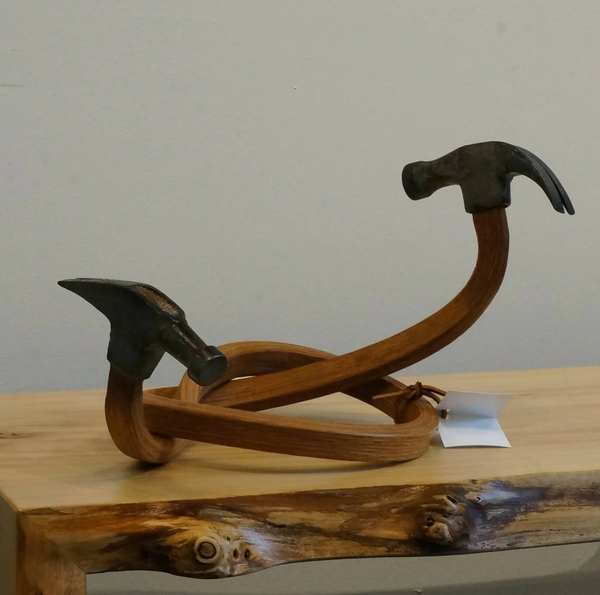
Bentwood Hammer Sculpture
Bentwood Hammer sculpture. Each sculpture is made from a single piece of solid hardwood about 3/4" x 1 1/4" x 48" long. Vintage hammer heads of various types are used. The wood is sanded and finished. Want 2? Free shipping if you order 2 (order here and shipping charges will be reversed). A short story about our hammer heads sculpture: Hammers grow on trees in bunches of two. We harvest the hammer inflorescences after they have dried, but before they fall to the ground (never set up a hammock under a hammer tree). The hammers must be separated from each other, and the stems are steam bent and dried to make straight hammer handles. They are shipped all around the world to be sold in hardware stores. All natural hammers are made this way, and we are the only ones to convert the natural curved stems to straight handles. Nature already offered a solution, and we just try to keep it as natural as we can. However, most hammer manufactures have the hammer heads ripped off their stems in the forests to save on shipping, and then put on a cheap plastic handle in a developing country. I’m sure you’ve seen the style, and may even own some of them. Except for us, no one takes the time to straighten out the natural curved handles that hammer heads already come with. There are several species of hammer head trees. We like to use the Ball Peen hammer head trees (Madagascar), and the Claw hammer head trees(Brazil). Sometimes we find a Hatchet head tree (Ohio), and then there are some rare trees that grow hammers for cobblers and luthiers(Vermont, New York). Hybrids between these trees do occur, and the interesting thing about them is that the inflorescence will have two different types of hammer heads. We have picked clumps of hammer heads that have cobbler hammers on one side, and luthier hammers on the other side. We have been able to take grafts off of these hybrid trees, and propagate them in our own woodlands so that we no longer have to denude forests of the hammer fruit in Madagascar and Brazil. It is important to us to be able to onshore this important resource for the DIY consumers. And our R&D department is working on using CRISPR modified hammer head stem cells to produce new kinds of hammer heads that no one knows they need yet. Needless to say that these growing plots are highly guarded with armed sentries to protect our intellectual property and to protect the future income from licensing growing rights.


